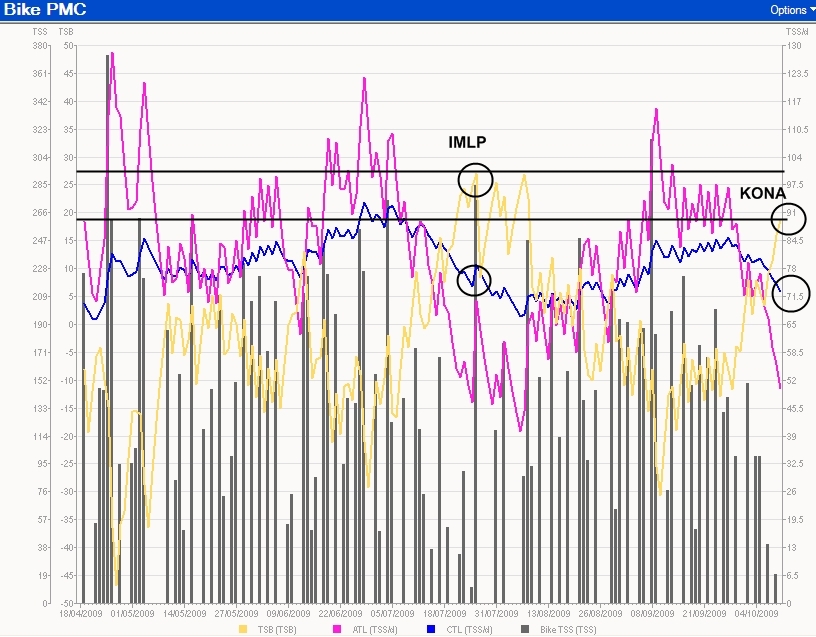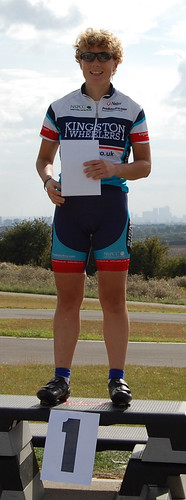The dilemma is this: in triathlon, you do three sports. At the Ironman level, I think we can assume most people swim a reasonable amount but not enough to have a severe impact on their training stress. Huge amounts of swimming just aren't a good return on investment for time spent training vs. time gained in the race. So that leaves us with cycling and running. Running tends to be harder on the body, requiring more recovery for most people after intense or long workouts. Cycling can be done in larger volumes and for longer periods at a time, as the impact on the joints is not as great. Thus the fatigue and associated recovery time from running is likely different than the fatigue and recovery from cycling. So the question is, why do we measure ATL (fatigue) on the same scale for both cycling and running? And more importantly, why would you want to pay much attention to a combined Training Stress Balance when that could hide vast differences in fatigue between the two? The answer is, you don't.
Once I had this "a-ha" moment, I looked back at my IMLP taper and sure enough, my TSB was +33, but that consisted of a bike TSB of +26, while the run TSB was a mere +7. In other words, no wonder my legs felt fatigued out there, my run was not nearly tapered enough! Too much running in the week or two leading up to the race led to this, which was caused by my blindly following my plan without thinking that my mileage up to that point had actually been below what the plan called for. Running 3-4 hours a week in training, then tapering by running 2-3 is not that smart. But low-mileage running is a topic for another post.
I haven't found much information yet on the "ideal" CTL, ATL and TSB numbers for the run vs. the bike in Ironman tapering (though digging through the Google Wattage list and other blogs has got me a bit closer to understanding it), but using Russ's numbers it looks like a run TSB of +15 or so worked for him. I'm aiming for a +12 on race day. I've also adjusted my run ATL to a 10-day constant rather than 7-day as I have on the bike. Wary that I backed off too much on the bike for IMLP, my bike TSB on race day in Kona will be +19 and I'm trying to limit my CTL losses to 13-14%.
See my charts below for the way it's going to look. Note that my TSB will be steadily climbing, rather than seesawing as it did for IMLP, and likewise my ATL and CTL steadily falling. And apologies for mixing and matching Performance Management charts from both SportTracks and WKO+. I finally spent a painstaking evening putting all my workouts between now and Oct. 10 into WKO+ and messing with the length/intensity of each to get what I believe now is a more ideal TSB. So the charts below reveal my new numbers:
run
TSB+12, CTL 37 to 30 for a loss of about 20% (that loss is perhaps still a bit high? but again, my run volume in general has been low compared to the intensity)
bike
TSB +19, CTL 85 to 73 for a loss of about 13-14% (TSB still a bit high, but we'll see how well I acclimatise to the heat and humidity in Hawaii)
total
TSB = +31, CTL 129 to 113 for an overall loss of 12-13%



1 comment:
Hi Maryka,
Very interesting blog post! In case you haven't seen it yet, you may want to check out Matt Fitzgerald's article on nailing the Ironman Marathon, which we recently posted on the TrainingPeaks blog here:
http://blog.trainingpeaks.com/2009/08/how-to-nail-the-ironman-marathon.html
Hope that helps! Also, please let me know if you'd be interested in being featured on the TrainingPeaks blog yourself! Thanks,
Elizabeth
elizabeth@trainingpeaks.com
Post a Comment